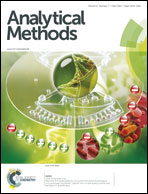Nonenzymatic sensing of methyl parathion based on graphene/gadolinium Prussian Blue analogue nanocomposite modified glassy carbon electrode†
Abstract
A new nonenzymatic electrochemical sensor was developed for sensitive detection of methyl parathion based on graphene nanosheets (GNs)/gadolinium Prussian Blue analogue (gadolinium hexacyanoferrate, GdHCF) modified glassy carbon electrode. The new sensor combined the individual properties of GNs (high conductivity and adsorption affinity) and GdHCF (high surface area and special catalytic activity), and realized efficient enrichment and electrochemical stripping voltammetric detection of methyl parathion. Under optimum conditions, the reduction current was proportional to methyl parathion concentration over the range from 0.008 to 10 μM with a detection limit of 1 nM. The sensor displayed high sensitivity, acceptable stability and selectivity, and realized reliable quantification of methyl parathion in practical environment samples.


 Please wait while we load your content...
Please wait while we load your content...